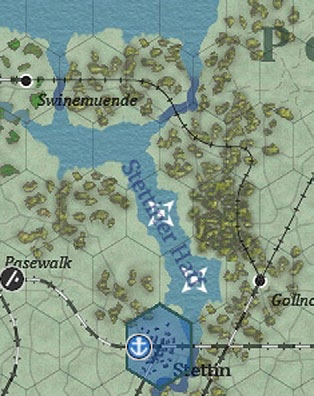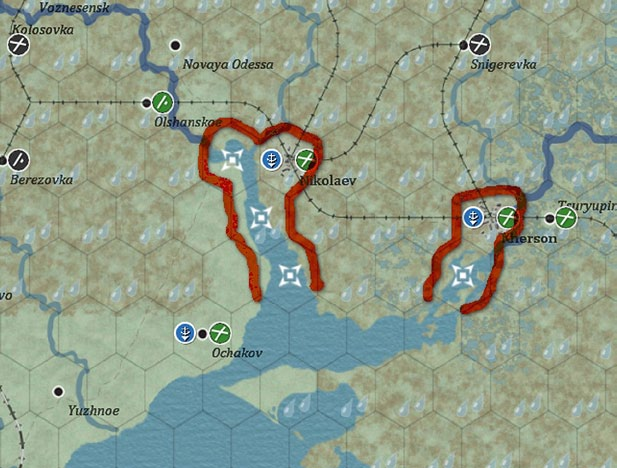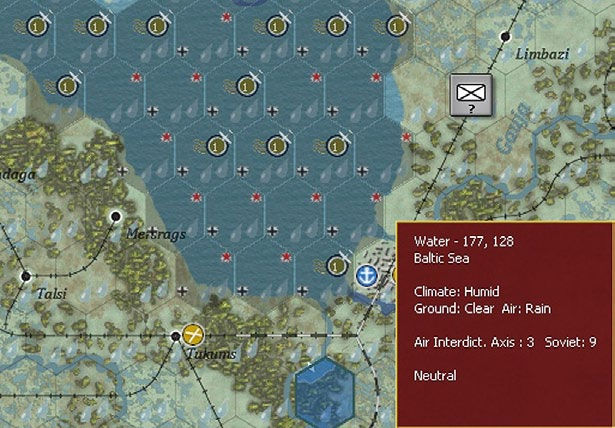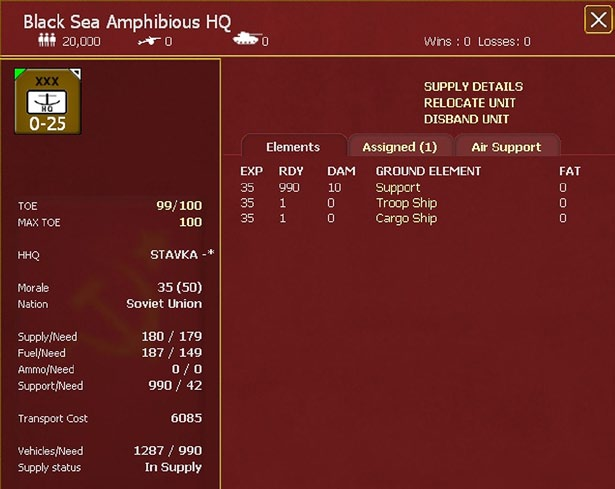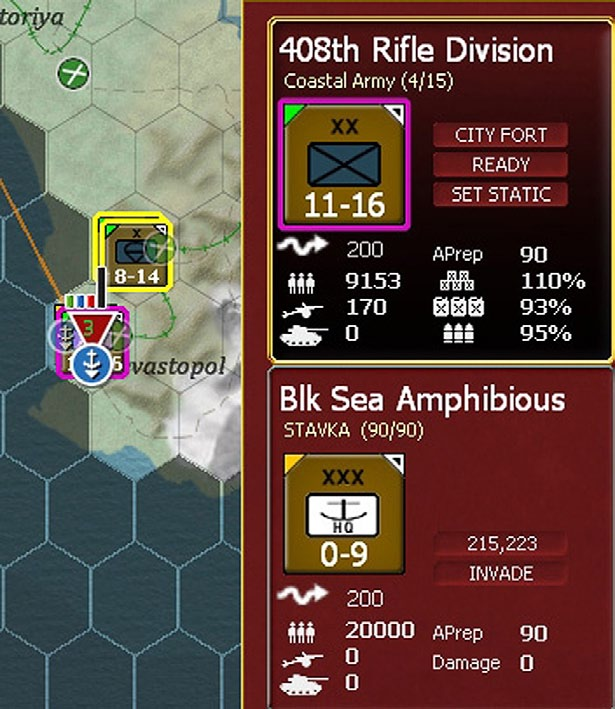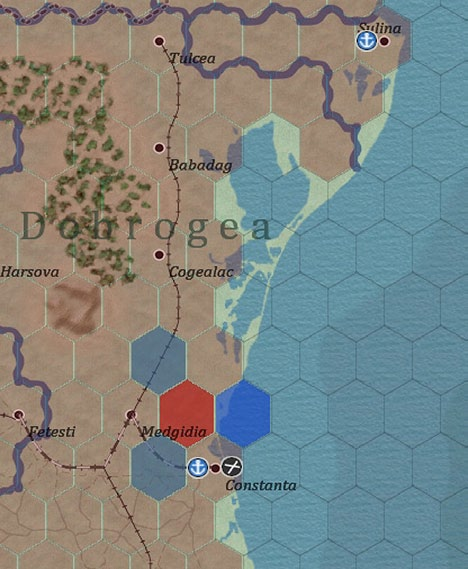24 Naval and Amphibious Operations
Focus: This section covers the various naval operations that can take place in WiTE2. This includes the naval transport of units and supplies, crossing contested ferry hexes and amphibious invasions.
Key Points:
- How Ports enable both the movement of supply and units
- How Temporary Ports are created
- How to move ground units by Naval Transport
- How Naval Transport moves Freight
- How to set up and conduct Amphibious Operations
Naval movement and operations in Gary Grigsby’s War in the East 2 include naval transport, amphibious transport, assault and naval gunfire support. In addition, naval units can combine with air units (18.1.8) to generate interdiction over sea hexes, disrupting or denying enemy operations in that zone.
Eligible units may utilize naval or amphibious naval transport to move through sea and ocean water hexes. Ground Units can move by naval transport between friendly ports and by naval amphibious transport from a friendly port to assault any eligible coastal hex. A shipping pool of troop and cargo ships is used to move units and freight by sea using strategic movement points (SMP). Amphibious transport and assault is limited to non- armoured combat units, is conducted in the amphibious phase during the enemy player turn, and requires the use of amphibious headquarters units and a certain amount of preparation time over a number of turns.
When in Naval Transport mode (F3), Amphibious Transport mode (F4), or Air Transport mode (F9), assigned (pending) amphibious invasion and associated airborne landing hexes will be displayed on the map. Amphibious landing ground hexes will be shaded red, the water hexes Amphibious HQ units will move to will be shaded blue and airborne landing hexes will be shaded light blue. In addition, when in either naval movement mode, the remaining Port Capacity for friendly ports will be displayed on the map for each port with the number in the port circles on the map equal to 1,000 tons of remaining load/unload capacity.
When in naval transport or naval amphibious modes and a unit is selected for movement, the naval contested hexes will be slighted darkened and enemy controlled hexes will be dark. Movement through these hexes is allowed, but at greater attrition levels (6.8.8). Units cannot move through or adjacent to an enemy amphibious HQ unit while in naval transport mode.
Units loaded ‘on ships’ are automatically put into ready mode and cannot be put into reserve or refit as long as they are on ships.
Entrained units may not move via naval or amphibious movement.
24.1 Transport Ships
There are two types of ships used for naval transport, troop ships for units and cargo ships for freight.
Troop ships have a capacity of 1,000 tons of unit load and cargo ships can carry 1,250 tons of freight. Each transport ship in the pool may be used for one mission per turn. Cargo ships used during the supply phase may not be used during the action (move) phase. Transports will be removed from the pool and attached to Amphibious HQ units to allow amphibious movement. When in naval or amphibious transport mode, the number of available troop and cargo ships is displayed in the general information and city box in the right hand corner of the screen.
For the Axis player, the map is divided into three areas, Baltic, the Black Sea and the connected Sea of Azov. For the Soviet player, their naval assets are split between five areas: the Baltic and Black Seas, the Sea of Azov, Lake Ladoga and the Caspian Sea. Each of these sea areas has its own allocation of cargo, and, if appropriate, transport, ships.
Only the Soviet player has the ability to conduct amphibious invasions and only in the Black Sea region.
24.2 Ports and Depots
There are two types of ports. Permanent ports are fixed pre-existing facilities that can be damaged, but will always be on the map. Temporary ports are established as a result of a successful amphibious invasion and represent the over the shore movement of units and freight at a beachhead that has been established by an amphibious landing.
24.2.1 Port Capacity and Damage
Each undamaged port has 15k tons of load/unload capacity. For example, an undamaged port level 2 will have 30k of capacity and will show a value of 30 in the port circle at the start of the turn when in F3 or F4 mode. Units cannot load/unload to/from ships at permanent ports unless sufficient port capacity is available. As port capacity is used up, the tonnage number in the port circle will decline. Loading/Unloading of freight in permanent ports also uses port capacity.
Ports with five percent or more damage will only operate at half of their normal capacity. A level 2 port with 20 percent damage would normally get 2 × 15,000 × 0.8 or 24,000 tons, but because it is over 5 percent damage, it will only get 12,000 tons.
When temporary ports are captured they are destroyed and removed from the map.
On the turn a permanent port is captured by either player, a depot is automatically built with supply priority 3 in the hex. If an amphibious landing succeeds in capturing the target hex then a temporary port with a level 2 depot set to priority 4 will automatically be formed in that hex. Ports have their port transportation capacity generated near the end of the logistics phase, so when a port is captured by regular ground combat rather than an amphibious invasion, it will not receive any capacity until the end of the next logistics phase, so no freight will enter on the next turn. Since amphibious invasions occur during the Axis player’s turn, In the Soviet logistics phase of the turn of invasion, they will gain some port capacity, but not much tonnage as the port is damaged at the time it receives its capacity. The port will receive some freight dependent on its size and percentage of damage.
If the port capacity is not used up loading or unloading units during the movement phase, it will be available in the next logistics phase to unload/load freight.
Barrage Balloons – All ports are assumed to have barrage balloons that will impact any raid that is bombing anything in the port’s hex. Aircraft bombing under 3,000 feet have a chance of being destroyed by the barrage balloon equal to two times the size of the port (so a port 3 means there is a 6% chance bombing aircraft will be destroyed). For night missions, the chance is tripled (so port level 3 has an 18% chance).
24.2.2 Inland Ports
Not all ports are directly on a sea hex. For example, Stettin in hex 143,164 traces a link to the Baltic via the Stettiner Haff. For an inland port to function, the player must have control of all of the land hexes along the river and/or ferry hexes between the sea and the port (both for unit and supply movement to/from the port).
On the main part of the map both Nikolaev and Kherson are dependent on control over the river and ferry hexes stretching down to Ochakov for them to function.
24.2.3 Special Rules for Temporary Ports
Temporary ports are only created in target hexes that don’t already have a permanent port, but if there is a size 1 or 2 port in the invasion target hex, the port will be immediately fully repaired upon capture.
Unloading of units in temporary ports does not use port capacity as the temporary port is simulating units and freight being offloaded at a beachhead. In all cases for loading/unloading, Transport ships must be available.
When a temporary depot is created (or a permanent port is captured) during an invasion, 250 tons of freight are placed in the depot for every cargo ship with the amphibious force being landed. . In addition, an airfield, with 50 damage points, will be created in the hex if it is clear terrain and freight from attached cargo ships will also be used to fill out the airbase units TOE.
A temporary port can only survive if a naval HQ is in an adjacent sea hex, so if there is no amphibious HQ adjacent, the temporary port will cease to exist but any airbase in the hex will remain.
Note: The Amphibious HQ can move during the Ground Phase with no effect. What matters is that at least one Amphibious HQ is adjacent to the temporary port during the logistics phase.
Temporary ports may be used for strategic naval movement, but not for accumulation of preparation points for amphibious invasion.
Temporary ports are considered to be national supply sources for the purposes of determining isolation. Newly created airfield units and those created in temp ports are given a supply priority of 3 when they are created.
Freight coming ashore to a temporary port takes attrition based on the air weather value (Clear 0, Rain 1, Heavy Rain 2, Cold 3, Snowfall 4, Blizzard 5) and the following formula:
10 + (weather value × 15) %
So in rain, 25% of the freight shipped to the depot will be lost.
24.4 Cargo Ship Freight Transport
Cargo ships are used to transport freight, normally between friendly ports during the logistics phase. Cargo ships are also attached to amphibious HQ units to deliver freight required to support amphibious assaults, to include temporary depots and air base units built as the result of a successful landing.
The number of ships in each sea area can be found on the production screen (36.3), as:
Further information about usage of cargo and troop ships in the logistics phase can be found in the Logistics Phase Log (36.9) under the ‘Freight’ sub- category:
Information about losses can also be seen on the ground loss tables (36.2.1).
24.5 Transport Ship Attrition and Interdiction
Ships may be lost, along with their cargo, whenever they are used for naval transport, amphibious transport, or for movement of freight during the logistics phase. Ships may also be lost when in an amphibious HQ unit. Note that for the purposes of this game, when a ship is described as being sunk, it actually represents ships sunk or damaged sufficiently to take them out of action for the rest of the game.
Half of any lost manpower in destroyed elements is place in the manpower transit pool.
Players will get a message on the screen if a troop ship is sunk during a naval transport move.
24.5.1 Logistics Phase Ship Attrition
Cargo ships used for movement of freight in the logistics phase have a one percent chance of being considered sunk but no freight will be lost as a result.
24.7 Amphibious Invasion and Assault
During the amphibious phase in the enemy turn, the invading ground units will attempt to move into the target hex. First the invasion force transport ships and ground units undergo landing attrition. If the target hex has defending enemy units, the invading ground units will conduct a deliberate attack to capture the hex.
24.7.1 Preparation for Amphibious Operations
Eligible combat units that begin their turn in a port, stacked with an amphibious HQ that has targeted a hex for invasion, will accumulate amphibious preparation points (APPs). Units may accumulate a maximum of ninety APPs. The number of APPs that may be accumulated in a single turn is dependent on the size of the port and varies with the size of the unit as follows:
- Add truncated (port value/2)
- Add truncated (54/size of forces in hex) where each combat unit in the hex has a size value where Division=9, Independent Brigade=5, Regiments and Broken down division units (1/ 2/ 3/ regiments and brigades) =3 and a permanently motorized unit has 1 added to the size. Amphibious HQs may not order an Invasion unless they have at least 50 prep points (no Invade button will be visible on the unit). Combat units must have at least 30 APP before they can participate in an invasion.
APPs will be set to zero whenever a unit completes an amphibious invasion or if the unit spends a logistics phase not in a permanent port hex or not stacked with an Amphibious HQ (moving from port to port will not cause the loss of prep points). Note that as long as a unit remains in a port in each logistics phase, it won’t lose prep points. It checks only during the logistics phase that it is in a port, and if not, that’s when it would lose prep points.
Attaching a support unit to a unit prepping for an amphibious invasion will result in the loss of 10 preparation points, though prep points will never drop below zero.
Amphibious HQ units and units stacked with them will not gain prep points when in a temporary port, nor will an amphibious HQ gain prep points when not stacked with an invasion capable combat unit.
APPs limit the amount of damage that the unit incurs while making an amphibious move.
In this case the Soviet 408 RD will accompany the Naval HQ in a planned invasion of Rumania. Note the unit has amphibious preparation points of 90.
If the amphibious transport mode (F3) is selected the target hex is shown in red. The two light blue hexes indicate pre-planned airborne missions in support of the landings.
24.7.2 Amphibious Invasion Attrition
Several factors go into determining the number of troop and cargo ships lost during an amphibious invasion, along with the number of ground elements that are destroyed and damaged, before any ground combat against defending units in the invasion hex is resolved.
The number of ships lost is dependent on the enemy naval sea and air interdiction capability, the fortification level of the defending hex (and hexes adjacent to the water hex containing the amphibious HQ) and the weather. These adverse factors are partly offset by the number of Preparation Points possessed by the invading force.
24.7.3 Amphibious Landing and Assault
If a target hex is occupied by an enemy combat unit(s) then the amphibious combat units must fight their way ashore with a deliberate attack. Naval support groups attached to the amphibious HQ will contribute fire support. If enemy units are in the target hex, the attackers will come ashore one landing at a time in a randomly determined order.
When an opposed amphibious landing results in a combat, the defender’s combat value is divided by a number equal to one plus the number of adjacent land hexes that are controlled by the attacking side. So if there was one adjacent hex controlled by Soviet airborne units and one hex controlled by a force from an invasion that just successfully came ashore, the defending force would have its CV divided by 3 (1+2) when determining the final combat odds. With the exception of naval support groups attached to the amphibious HQ unit, support units in HQ units will not participate in amphibious landing combat.
During an amphibious invasion attack against a non- port hex, the defending units may only use the CV value of the largest unit in the hex, and if that unit is a larger than a regiment or brigade, it will only use 1/3 of that unit’s CV value. All units will participate in the battle, but only the one unit will count in the after battle CV value that determines the winner of the battle. Axis units next to enemy amphibious HQ units are not eligible to come in to a battle from reserve.
If an amphibious assault fails, the ground units will remain ‘on ships’ in the same water hex with the amphibious HQ unit, representing the evacuation of the surviving assault forces back to the transport ships. All prep points are lost.
Amphibious HQ units will use their naval support units to fire into any combat where the defender in the combat is adjacent to the Amphibious HQ (they will fire as an attacker or defender, as long as they are adjacent to the defender’s hex). Naval support units suffer disruption prior to their firing in combat when adjacent to enemy hexes with forts and/or ports. The amount of disruption is determined by adding up the fort levels of every enemy hex adjacent to the Amphibious HQ, and adding 1 for every enemy port adjacent to the Amphibious HQ. The larger this number, the greater the disruption. This represents the effects of enemy naval guns within range of the Amphibious HQ.
At the end of every Soviet player turn air execution phase, any amphibious HQ unit with combat vessels will automatically bombard all adjacent Axis ground units potentially causing damage to some Axis ground elements in both the combat units and any attached support units.
24.7.4 Hold at All Costs Defense
Defending units on a temporary port hex, or adjacent to a temporary port hex and also adjacent to a sea hex, will have their end of combat CVs multiplied by 4 when determining whether they retreat.
If they hold, but would have retreated had they not received this bonus, they will instead suffer additional losses to reflect their fighting to the last to hold the beachhead. The existence of a temporary port is noted in the hex pop-up information.
